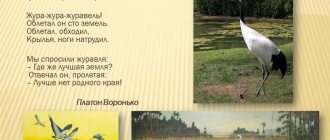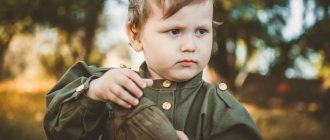Abstract of the educational activity "Streets of our city" senior group
Abstract of the educational activity “Streets of our city” in the senior group.
Integration of educational modules
:
“Cognitive development”
, (“Construction” “Scheme-plan of our kindergarten”),
Cognitive development”
(Research activities), “Foreign language” (English), “Playing game” (“Symbols”),
“Socio-communicative development"
,
"Communication"
Goal
: to cultivate in children love and a sense of pride for their street, hometown, native land.
Tasks:
- consolidate children's knowledge about the concept «Street»
, knowledge of your address and the address of the kindergarten, the ability to talk about the street on which the child lives;
- continue to introduce your hometown;
- activate vocabulary, cognitive;
- attract children's attention to this topic with the help of modern computer technologies (OO "Cognitive Development"
);
- develop speech, observation, attention, memory, thinking, perception;
- develop fine motor skills;
- Enrich your understanding of the world around you constructed objects
: buildings for various purposes.
- Develop skill design
objects according to a specific condition
(plan)
.
( "Cognitive Development"
).
- Develop collective relationships between children through common purpose - streets
, the ability to bring something started to completion.
( "Socio-communicative development"
).
- Consolidate knowledge of home address ("Social and communicative development"
).
- Develop attention, imagination, intelligence. ( "Cognitive Development"
)
Preliminary work
: conversations about home address; address and name of the kindergarten; names of city streets; a story about what our region is famous for;
Materials and equipment
: photographs of city streets, presentation
“Native Streets ”
, multimedia screen, cards for speech development, cards for “Playing Game”, ice, snow, paper napkins, magnetic and wooden construction sets, pencils, envelope, magnifying glass, Dienesh blocks.
GCD move:
1. Organizational and motivational part
- Guys, listen to the poem and guess what we will talk about:
In the morning the sun rises,
He calls everyone to the street,
I'm leaving the house -
Hello, ... (my street)!
2. Educational module: Communication
Introduction to the game situation.
- That's right, we will talk about the streets of our city. Santa Claus is coming to visit our city! He doesn't know where we live. ( screen “Santa Claus” - greeting).
2.1. Presentation (city streets, attractions)
-Guys, what country do we live in? (Children's answers)
-Which city is the capital of Russia? (Children's answers)
— Guys, what is the name of our city? (Children's answers)
— That's right, Nizhnevartovsk. And all its residents, that is, we, are... ( Introduction of new knowledge
- Vartovites, Nizhnevartovians)
And our task is to tell as much as possible about our city and its sights. ( Introduction of new knowledge
: What is a “landmark”? is a place or object in the city that deserves special attention).
— I suggest you go for a walk through the streets of our city. This will not be a simple walk, but a photo walk. (Presentation)
(Airport, railway station, Alyosha monument, Palace of Arts, Drama Theatre, Barabashka Puppet Theater) Conversation about each attraction.
— There are many streets in our city. Name, what streets do you know? (Children's answers)
.
— What is an address? (Children's answers)
— Why do you need to know your address? (Children's answers)
- Who can tell me their address? (Children's answers)
— On what street is our kindergarten located? (Children's answers)
— What is the name of our kindergarten? (Children's answers)
Practical part
—
We talked a lot about the streets. What letter does this word begin with? (Children's answers)
—
Let's use the cards to determine by ear where the sound “U” is located and highlight it in red, because he is a vowel.
The letter “U”, finding the sound in a word (at the beginning, middle, end).
—
We told Santa Claus about our city and attractions. But he doesn’t know what our kindergarten looks like. Let us try to build the territory of our kindergarten using a construction set.
3. Educational module “Design”
Work in subgroups of 4 people
.
-How many floors will our building have? (Children's answers)
(Photo of the kindergarten)
-How many verandas do we have on the territory of the kindergarten? (Children's answers - 10)
-What colors are they? (Children's answers - yellow veranda with a blue roof)
(Photo)
— Do you have a sled? Have any of you ridden them? (Children's answers)
-What does it take for a sled to run well? (Children's answers: snow)
-What does Grandfather Frost travel on? (Children's answers - on a sleigh)
Let's collect napkins together on our plan to recreate the snow. (Children tearing napkins - Development of fine motor skills
)
4. Physical education minute (video)
5. Educational module “Research activities”
Guys, we need to warn Santa Claus about our climate.
-Where do we live: in the South or in the North? (Children's answers - in the North).
-What time of year is it now? (Children's answers)
-What month is autumn? What is it called? (Children's answers)
-What do you and I have lying on the street? (Children's answers)
Guys, look, I want to show you snow and ice. Let's touch them. What do you notice about the same quality between them? (Children's answers)
-What does snow consist of? Where does it come to earth from? (Children's answers)
-What color is the snow? (Children's answers)
-What kind of ice? (Children's answers)
-And if you touch the ice with your hand, what is it like? (Children's answers)
Guys, let's sprinkle sand on the ice and see what has changed (It's no longer slippery).
That’s why guys sprinkle the ice on the streets with sand so that people don’t slip. an experiment with you
: leave ice in one plate and snow in the other. And let's see what melts faster.
6. Educational module “Foreign language”.
Guys, let's remember what was the last word in English we learned? (Children's answers)
That's right, black - black.
Guys, please look at the snow. What colour is he? (Children's answers)
That's right, white. In English, "white" sounds like "white". Let's say "white" together.
Presentation – the word “ white ”.
Let's play the game “Name the Color”. Pictures of black and white objects in the presentation.
7. Educational module “Igralochka”
Guys, you know, what is the most important thing for you in the New Year? (Children's answer is to receive gifts).
Grandfather Frost asked us, so that no one would know what gifts you want, to encrypt them using the symbols that we use in mathematics.
Now I will give you some leaflets. And everyone will encrypt with the help of symbols and icons what kind of gift they want. Work on pieces of paper.
-Let's remember, guys, what icon do we use to indicate size, color and shape? (Children's answers)
Guys, Natalya Rifatovna asked me to order a gift. But I lost her encryption. Can we help her? Let's encrypt the characteristics of Natalya Rifatovna's gift using the picture.
Thank you guys, now Grandfather Frost will receive your wishes and prepare your gifts for the New Year.
8. Reflection
- Guys, what new did you learn today? (Children's answers)
Presentation – Santa Claus
You guys are great! You helped Grandfather Frost a lot. Now he knows that he cannot walk on “bare” ice, because he can fall. You need to walk on ice sprinkled with sand. He will receive our letter and decipher what gifts you want and no one will know about it except him.
Summary of the lesson in the senior group of the preschool educational institution “My city is my small Motherland”
- September 30, 2016
Purpose of the lesson: speech development, learning to compose stories about the small Motherland.
Tasks:
- disclosure of the concept of “city”;
- acquaintance with the native village, enrichment and expansion of knowledge about the memorable places of the village;
- determining the distinctive features of a village and a city;
- nurturing love for one’s native village;
- acquaintance with oral folk art through proverbs and sayings about the Motherland, native land.
Progress of the lesson
- Guys, let's imagine that today you and I are going on a trip. What do you think you should take with you when going on a long journey so as not to get lost? (Children's answers)
- That's right, you need to take a card. I decided to take this card. What do these dots represent on it? (Children's answers). Why are the dots different, big and small? (Children's answers).
– Do you know why a place where many people live is called a city? Let us say the word “city” slowly, and listen to this word.
the city in the ancient way : Moscow-grad, Chelyabinsk-grad. In ancient times, there were frequent wars over land. To protect themselves from enemies, people fenced themselves with high fences and then erected fortresses. Do you hear a familiar word in the words “fence”, “fenced”? (Children's answers).
Yes, the word is "city". Since then, the fenced area has been called a city. Thus, from the ancient word “hail” the modern word “city” was formed.
– There are many cities on our planet. Everyone has their own name, just like a person. Cities are young and old, noisy and calm. What cities have you visited? (Children's answers).
Where do you and I live? (Children's answers).
- That's right, in the village of Novogorny. Tell me, what is the difference between a village and a city? (Children's answers).
– Yes, they differ in size: the city is large, and the village is small. And in cities there are tall buildings - skyscrapers . Repeat “skyscraper” with me. These houses are so called because they rise above other houses, and it seems that the roof reaches the sky, that is, “scraping” the sky. Hence the name “skyscraper”.
– There are a lot of cars moving along the city streets, but in our village there are few.
– Also, a lot of people live in cities, but in our villages there are fewer.
– Guys, please tell us about our village. And so as not to forget anything during the story, I propose to draw up an outline of this story from the helper pictures. The first picture will indicate the name of our village.
– Based on the second beautiful picture, you will need to describe how beautiful our village is. The third picture will help you tell how beautiful our village is at any time of the year. Based on the last picture, tell us about your favorite place in our village.
(Listening to children's stories).
– Well done, you have some interesting stories! You and I are one big, friendly family living in the same village. They say about us that they are fellow countrymen. You and I love our hometown, our land. People have been glorifying their land for a long time. There are many proverbs and sayings about this. What proverbs and sayings do you know? (Children's answers).
- Everyone loves their native side
- Where someone is born, that’s where they will come in handy
- Houses and walls help
- Your own land is sweet in a handful
- You can even dream about your native land.
– Please name the main attractions of our village.
– What kind of plant do we have?
– What enterprises do the residents of our village work at?
- Well done, we will love our native village, take care of its purity and beauty. And now I propose to draw your favorite places in the village.
Summing up: children can talk about their hometown, try to come up with a short story on a given topic; able to use simple symbols and diagrams.
Author: Teacher of the senior group of kindergarten Elovik Tatyana Aleksandrovna, Novogorny village.

